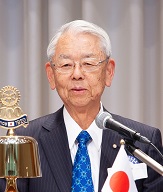Regular Meeting in the Rotary-no-Tomo Month
Making Rotary-no-Tomo Your Favorite Magazine
October 16, 2019
Mr. Mondo Katayama
Chairman of Rotary-no-Tomo Committee
Director of Law Firm, Law Monde
�� I feel honored to speak about our monthly magazine Rotary-no-Tomo (aka Tomo Magazine) at Tokyo RC which is like a great-grandfather of Nagoya Southeast RC where I belong. Today I am invited as Chairman of Rotary-no-Tomo Committee as well as Representative Director of Rotary-no-Tomo Secretariat. I will explain the reason and relationship of these two entities together with the history of Tomo Magazine that extends over sixty years.
I feel honored to speak about our monthly magazine Rotary-no-Tomo (aka Tomo Magazine) at Tokyo RC which is like a great-grandfather of Nagoya Southeast RC where I belong. Today I am invited as Chairman of Rotary-no-Tomo Committee as well as Representative Director of Rotary-no-Tomo Secretariat. I will explain the reason and relationship of these two entities together with the history of Tomo Magazine that extends over sixty years.
��At the outset, let me highlight the three duties as a Rotarian which are to ��pay the membership fees,�� ��attend the regular meetings�� and ��subscribe to Tomo Magazine��. I must admit RI obliges RCs to pay the subscription fees but does not go so far as to oblige each Rotarian to actually ��read�� the magazine. It is up to each Rotarian to read or not to read the Magazine. As such, the Editorial Board strives to make Tomo Magazine worth its subscription fees by creating informative, interesting, appealing and attractive contents.
��Today, I have distributed the ��Rotary-no-Tomo Manual�� to help you deepen understanding on the Magazine together with my explanation. A free copy of the Manual is given to District Representative Committee members each year. On the cover page, you find the July edition of Tomo Magazine with a photo of the newly-appointed RI President, Mr. Daniel Maloney and his wife. The very first issue of Tomo Magazine was published in January 1953 and you find it with the traditional woodblock ukiyo-e print of Mt. Fuji by a renowned artist Katsushika Hokusai. The print is entitled ��Clear Day with a Southern Breeze�� and we selected it with warm wishes for the successful launch of the Magazine.
��The second page of the Manual shows the official magazine of RI ��The Rotarian�� and 32 official regional magazines, together with information on its annual publication frequency, number of pages, circulation, and the year of the first issue. ��The Rotarian�� was first published in 1911 and has a circulation of 500,000 copies today. Tomo Magazine had a circulation of 3,300 back in 1953 but today it totals 95,500 copies. Page 5 of the Manual explains the background that led to the birth of Tomo Magazine. The very first Rotary District was established in Japan in 1949, after the end of WWII. As the number of RCs and membership skyrocketed, RI had to divide the District into two by 1952 to accommodate every member. District Directors wished to promote friendship and enhance good communications between the two Districts and decided to collaborate and make a magazine named Rotary-no-Tomo. Interestingly enough, it was only in 1980 when RI officially granted permission to issue the Japanese version of the Magazine out of necessity. Considering the size of membership that exceeds 1.2 million around the world, there is no way RI could have printed and distributed such an enormous number of copies. RI gradually came to realize the necessity to promote ��local production for local consumption.�� In other words, it came to accept creating magazines locally with contents and information that suit Rotarians of each locality, promote friendship as well as ensure two-way communication between RI and local RCs.
��Let me now briefly speak about the relationship between the Rotary-no-Tomo Committee and the Secretariat. When Tomo Magazine was approved as the official regional magazine in 1980, RI gave some conditions which included that a District Advisory Committee must be set up to supervise the overall publishing operations, that it shall be economically independent from RI and establish a sound financial basis in the long run, as well as it shall not request for indemnity nor file a complaint on RI. On the other hand, the Secretariat engages in economic activities by having a dedicated staff, possessing real estate, bank accounts and insurance. As such, it was most suitable to delegate the functions of management policy decision making as well as supervision of operational execution to the Committee, whereas to incorporate the Secretariat to roll out economic activities on a sound basis. As the Committee doesn��t have a dedicated staff member, assets nor property, the majority of the members serve both the Committee and the Secretariat, except for ��District Representative�� and corporate auditor. The price of the magazine has remained at 200 yen since 1975.
��Before I close my speech, let me highlight that the mission of Tomo Magazine can be achieved only when Rotarians purchase and read it. As I represent both the Tomo Magazine Committee and Secretariat, I want to reiterate my commitment to create a good magazine that makes you feel happy, relaxed and uplifted. I hope Tomo Magazine will become your favorite reading material.